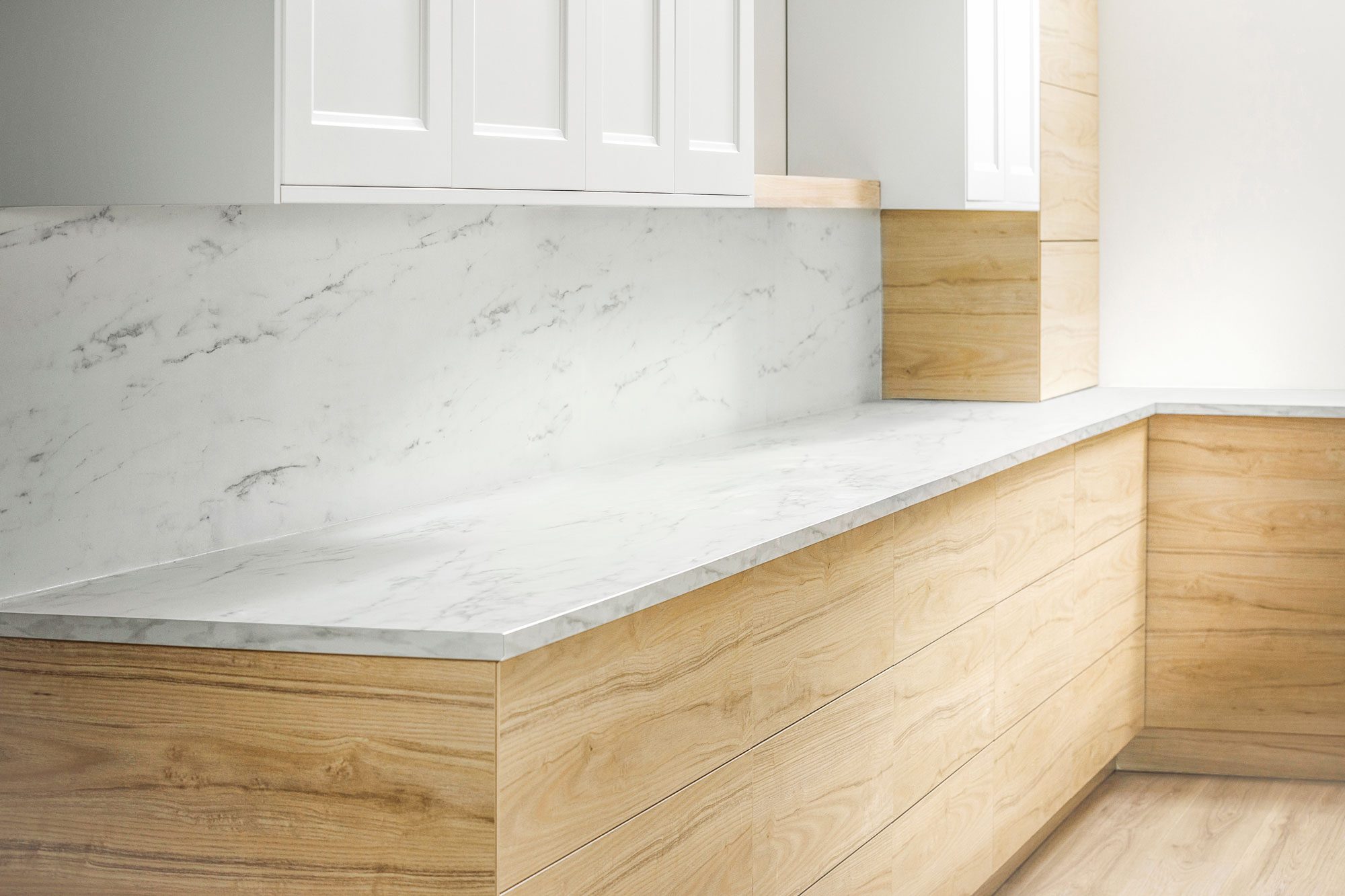Here's how to install ikea kitchen cabinets like a pro.
Varies
Intermediate
Varies
Introduction
Save thousands on renovation costs by following our step-by-step project for installing Ikea kitchen cabinets in your home.
Renovating your kitchen can be quite expensive, but a great way to save money is by doing the labor yourself. While installing kitchen cabinets may seem intimidating, it becomes much easier once you get the hang of it. Installing Ikea kitchen cabinets can simplify the process compared to traditional cabinets. Ikea cabinets feature a suspension rail system for easy installation and adjustment of cabinet placement.
I highly recommend taking the time to plan your cabinet layout before starting the installation. Make sure to account for the space needed for appliances, floating shelves, and any other elements that will affect the cabinet locations. The more preparation you do upfront, the smoother the installation process will be.
Tools Required
- 2-ft. Level
- 4 ft. level
- Assorted drill bits
- Clamps
- Drill
- Eye protection
- Flat screwdriver
- Hearing protection
- laser level
- Miter saw
- Philips Screwdriver
- Portable band saw or angle grinder
- Square
- Stud finder
- Tape measure
Materials Required
- 1-1/8-inch screws
- Ikea cabinet trim (optional)
- Ikea cabinets
- Ikea cover panels
- Ikea toekick w/connectors
Project step-by-step (16)
Remove old cabinets
It’s essential to remove all items from the kitchen cabinets, including appliances and shelves. Use a drill to unscrew the cabinets from the walls and/or from each other before gently detaching them from the wall.

Check for a level floor
Most kitchen floors are very flat, especially in homes less than 40 years old. But before installing cabinets, it’s always best to confirm that by looking for the highest spot on the floor anywhere a cabinet will sit. You’ll measure up from that spot and draw a level line to define the top of all the base cabinets.
Then mark the highest spot on the floor and repeat near any other walls that’ll have cabinets. Continue until you find the highest spot.
If you have two high spots, rest the board on both and find the highest one.
Measure up the wall behind the highest spot 34-1/2-in. (standard cabinet height) and mark the wall at that point. Using that mark as a starting point, draw a level line along the walls wherever base cabinets are planned. You can also use a laser level to make your life easier.

Assemble and dry-fit cabinets
Completely assemble all the cabinets according to Ikea’s instructions. Check your cabinet layout by “dry-fitting” all the base cabinets, starting with the corner ones, and setting all the cabinets in place side-by-side as tightly together as possible. If the layout calls for filler strips, make sure to leave spaces for those, too. With the cabinets in place, check to ensure drawers and doors clear one another, appliance openings are the proper widths and sink bases center under windows above.
Unless your cabinet plan is flawed, any adjustments you’ll need to make are just a matter of ripping filler strips narrower or using wider ones. Next, remove the shelves, drawers and doors and mark them and their matching cabinets with numbered masking tape to save time and confusion later. Then, move the cabinets out of the way.
Cut the suspension rail
Measure the total length of the row of cabinets to determine the lengths needed for the suspension rails. Cut the rails about 3/4-in. shorter than the cabinet run to conceal them from view. Use a portable band saw or an angle grinder for the cutting process.

Install the lower suspension rails
Attach the suspension rail to the back of one of the loose base cabinets and measure its height. The cam that attaches to the suspension rail can be attached to the cabinet interior at several different locations. The height of the suspension rail will vary depending on which location is used.
I assembled these using the lower cam location, which required me to install the bottom of the suspension rail level 30-15/16-inch from the high spot on the floor or 3-9/16-in. below the 34-1/2-in. “top of cabinet” line we marked in step two.
Use a stud finder to locate the studs in the kitchen wall, which are usually spaced 16-in. apart. Mark the studs with a pencil and a level to show straight vertical lines. Attach the suspension rail to the wall studs using a drill to drive in the screws and washers included with the rail. If the very end of the suspension rail lands between two studs, secure it using a drywall anchor.

Install the base cabinets
Start with the corner cabinet and attach the bottom cabinets to the suspension rails with the cams attached to the back of the cabinets. Once installed, secure the plastic locking mechanism that attaches the cam to the suspension rail at the back top corners of the cabinet. Use a flathead screwdriver to turn the mechanism clockwise until it is tight.

Adjust the cabinet legs
After you have hung the base cabinets, adjust the cabinet legs to bring the cabinets to the required height. Use a two- and four-foot level to ensure each cabinet is level front-to-back and even with the other base cabinets.

Secure the base cabinets together
Screw the base cabinets together with 1-1/8-in. screws. I used four screws, one near each corner to hold each set of cabinets together. To avoid interfering with the drawers, ensure that the screw heads are as flush as possible.

Attach the toe kick
With all the base cabinets installed, attach the Ikea toe kick to the base cabinet legs using the clips purchased from IKEA for this exact installation. Use a miter saw to cut any mitered ends that your cabinet layout requires, keeping in mind that you may have to trim the height of the toe kick to match any humps in the floor.

Install the upper suspension rails
If you purchased Ikea cabinets that are standard countertop height, it may be easier to install the countertop before moving on to the upper cabinets. Sometimes, the cabinets will share a suspension rail, while other times they require their own. It all depends on the specific cabinet layout.
If you install cabinets close to the ceiling, it is extremely important to ensure that the ceiling does not sag. If it does, you will need to adjust the upper suspension rail height accordingly to ensure that the cabinet doors can fully open. Fortunately, our ceiling was plenty tall, so we did not have to worry about that.
Cut the suspension rail to length, determine its position, and secure it level on the studs in the same manner as you did the base cabinet suspension rail.

Hang upper cabinets
Attach the upper cabinets to the suspension rails and lock the cams. If you’re working alone, clamp a board to the side of the cabinets to help take off some weight while you maneuver each one into place.
Then, use a drill to join the cabinets together with the same 1-1/8-in. screws. If applicable to your project, start with a corner cabinet and work your way out.

Install cover panels on the finished ends
Secure cover panels to match the finish of the doors and drawer fronts on the outside of the end cabinets. Once they are level and the front edge aligns with the drawer face, clamp them to the cabinet and fasten the panels with 1-1/8-in. screws from the interior of the cabinets. Make sure that everything is level and straight. In some cases, you may need to cut or scribe the panels to size, depending on the specific IKEA cabinets and corresponding cover panels you ordered.

Add cabinet hardware covers
Attach the plastic hardware covers to the corners of the cabinets where the suspension rail cam hardware is visible. The covers fit securely onto the hardware within a pre-made channel to prevent them from coming off.

Add top trim (optional)
If you did not order the upper trim for the cabinets, you can skip this step. The trim is machined with channels and special angle brackets that fit into place and are screwed to the top of the upper cabinets. Use clamps to hold the trim in place while you secure it with the included screws.

Finishing touches
Reinstall the drawers on their matching drawer slides and snap the cabinet doors into their installed connection plates. Use a Phillips head screwdriver and the three exposed hinge screws to align and adjust the cabinet doors.
Congratulations, your Ikea cabinets have been installed. It is now time to install the countertops and drawer pulls.

FAQ
Do you install top or bottom cabinets first?
Either installation order is acceptable, as it depends on the specifics of the project. If you’re pressed for time and need to install the countertops quickly, you should install the bottom cabinets first. However, if you want to ensure ease of working around the lower cabinets, it’s better to install the upper cabinets first.
Do you screw base cabinets to the floor?
If the cabinets are freestanding base cabinets on a kitchen island or peninsula, they need to be secured to the floor if they are not secured to the wall.
Should you put flooring under cabinets?
Typically, installing the flooring before you install the kitchen cabinets is recommended.





















